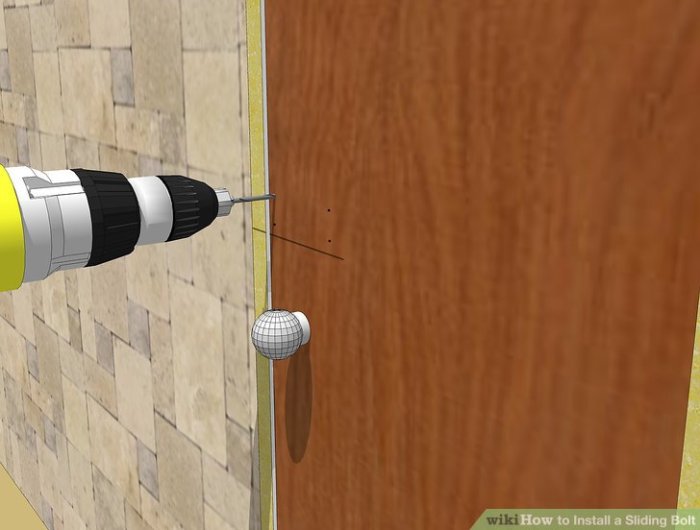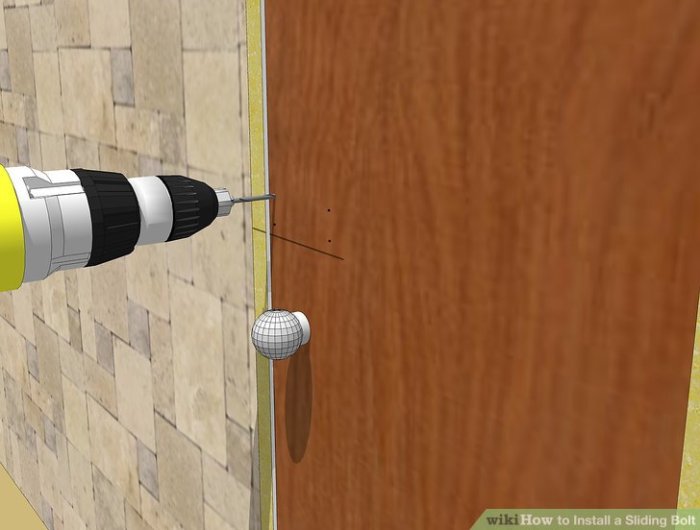Wire a Wall Switch lays out a clear and comprehensive guide for tackling electrical projects. From understanding the basics of single-pole switches to mastering the intricacies of 3-way and 4-way setups, this guide provides a detailed breakdown of the wiring process. We’ll cover everything from safety precautions to troubleshooting common issues, ensuring you have the knowledge to confidently wire your wall switches.
This in-depth guide walks you through the entire process, covering various switch types and their unique wiring configurations. We’ll delve into the specifics of each type, highlighting the differences in wiring and providing clear, step-by-step instructions. You’ll learn how to connect the switch to the power source and to the light fixture, as well as how to identify and avoid common mistakes.
Introduction to Wiring a Wall Switch
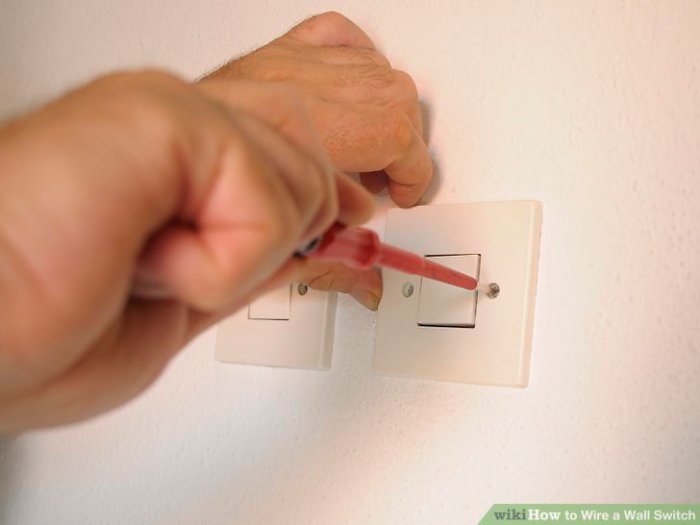
A wall switch is a fundamental electrical component that allows us to control the flow of electricity to a light fixture or other appliance. Its purpose is to interrupt and restore the electrical circuit, enabling us to turn a light on or off. This simple action relies on a precise arrangement of electrical components and careful attention to safety protocols.Wiring a wall switch involves several crucial steps and components, each playing a specific role in the overall circuit.
Proper installation ensures the safety of occupants and the longevity of the electrical system. Understanding the wiring process, including safety precautions and the specific components involved, is vital for any DIY electrical work.
Essential Components
A typical wall switch circuit includes several key components: the switch itself, the electrical wiring (typically copper wires), the electrical box, the power source (e.g., the electrical panel), and the load (the light fixture). The switch acts as a break in the circuit, controlling the flow of electricity to the load.
Safety Precautions
Electrical work necessitates adherence to strict safety protocols. Before beginning any wiring project, always turn off the power at the circuit breaker. This crucial step prevents electric shock and potential injury. Use insulated tools and ensure proper grounding procedures are followed. If you are not comfortable with electrical work, consult a qualified electrician.
Safety should always be the top priority.
Basic Wiring Diagram
The following diagram illustrates a typical wiring setup for a single wall switch. The diagram shows the connections between the switch, the power source, and the load (light fixture).
+-----------------+ +--------+ +-----------+ | | | | | | | Power |-----| Switch |-----| Light Fixture| | Source | | | | | | | +--------+ +-----------+ | | | (e.g., | | Circuit | | Breaker) | +-----------------+ (Line) (Load)
This simplified diagram shows the hot wire (typically black), neutral wire (typically white), and ground wire (typically bare copper or green).
The switch is wired in series with the hot wire, allowing it to control the flow of electricity to the light fixture.
Electrical Symbols
Understanding common electrical symbols used in wiring diagrams is essential for interpreting and executing the wiring process accurately. These symbols represent different electrical components and connections.
Wiring a wall switch can seem daunting, but it’s actually pretty straightforward. The process is fairly simple, and once you get the hang of it, you’ll be a pro. Plus, knowing how to wire a wall switch can save you a bundle of money by avoiding costly electrician calls. If you’re looking for some inspiration on tackling home improvement projects, check out the brilliant work of brain aka matthew dear boss brain aka matthew dear boss.
Their creative approach to DIY projects is truly something else. Just remember to always prioritize safety when working with electricity, and you’ll be well on your way to a successfully wired wall switch.
| Symbol | Component |
|---|---|
 |
Switch |
 |
Light Fixture |
 |
Electrical Wire |
 |
Power Source (e.g., Circuit Breaker) |
Types of Wall Switches
Wall switches, seemingly simple devices, are actually quite versatile. Understanding the different types and their wiring configurations is crucial for any DIY electrician or homeowner tackling a wiring project. Different switch types offer various functionalities, making them suitable for different applications in a home or building.
From the basic on/off functionality to more complex control setups, the types of switches available cater to a range of needs. This exploration delves into the specifics of single-pole, 3-way, and 4-way switches, highlighting their wiring differences and applications.
Single-Pole Switches
Single-pole switches are the most basic type. They control a single light fixture or appliance directly from one location. This simple design makes them ideal for most residential lighting.
- Wiring Configuration: A single-pole switch has two terminals, commonly labeled “Line” and “Load.” The Line terminal connects to the electrical supply, and the Load terminal connects to the light fixture. The switch itself connects between Line and Load, effectively interrupting the circuit when turned off.
- Functionality: A single-pole switch provides the simplest on/off control. Turning the switch on completes the circuit, allowing current to flow to the load (light). Turning the switch off interrupts the circuit, stopping the current.
- Applications: Single-pole switches are the most common type found in homes, used for a vast array of single-light fixtures.
3-Way Switches
3-way switches allow control of a single light fixture from two different locations. This is often used in hallways or stairwells.
- Wiring Configuration: A 3-way switch setup requires two 3-way switches. Each switch has three terminals: two for the wires from the electrical panel and one for the wire to the light fixture. One switch is wired to the power source, and the other to the light fixture. Connecting wires between the switches complete the circuit.
- Functionality: When one switch is turned on, the circuit is completed, and the light turns on. Turning the other switch on or off does not affect the light’s status.
- Applications: Ideal for controlling lights from multiple locations, providing flexibility in controlling lighting in hallways, stairwells, or rooms with multiple entry points.
4-Way Switches
4-way switches are used in conjunction with 3-way switches to extend the control to three or more locations.
- Wiring Configuration: A 4-way switch, like a 3-way, has three terminals. They are used to connect the circuits between multiple 3-way switches. The 4-way switch’s purpose is to direct the current flow between the 3-way switches and the light fixture.
- Functionality: A 4-way switch acts as an intermediary in the circuit. It receives the signal from a 3-way switch and transmits it to another 3-way switch or directly to the light fixture.
- Applications: 4-way switches are used to control a single light from three or more different locations, enhancing flexibility in large rooms or complex lighting systems.
Comparison Table
| Switch Type | Terminals | Wiring Configuration | Functionality | Applications |
|---|---|---|---|---|
| Single-Pole | 2 | Line to switch, switch to load | Simple on/off control | Most common residential lighting |
| 3-Way | 3 | Requires 2 switches; one to power, one to load | Control from two locations | Hallways, stairwells |
| 4-Way | 3 | Intermediary between 3-way switches | Control from multiple locations | Large rooms, complex lighting systems |
Wiring Procedures for Single-Pole Switches
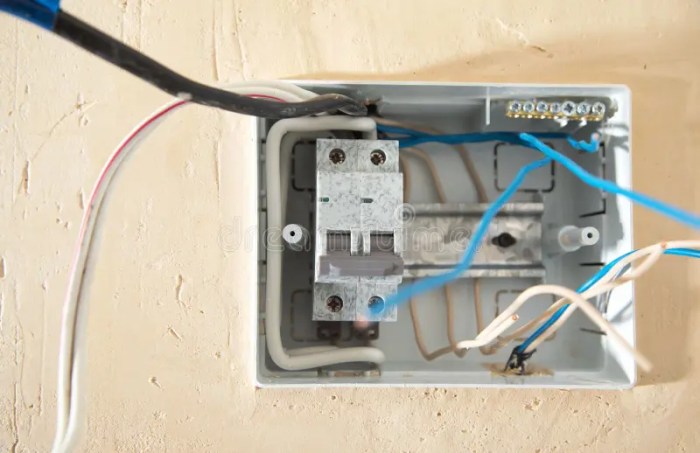
Wiring a single-pole wall switch is a fundamental electrical task, enabling control of a single light fixture or appliance. This process involves connecting the switch to the power source and the load (the light fixture) using appropriate wiring techniques. Understanding these procedures is crucial for ensuring safety and proper functionality.
Preparing for Wiring
Before starting any electrical work, safety is paramount. Ensure the power is switched off at the circuit breaker or fuse box. This is an essential step to prevent electric shocks. Use non-contact voltage testers to confirm the power is completely off at the relevant circuit. Gather necessary tools and materials, including wire strippers, wire connectors (e.g., wire nuts), and a voltage tester.
Inspect the switch and fixture for any damage. Identify the wires on the switch and the fixture. Familiarize yourself with the color coding scheme of the wires used in your electrical system.
Connecting the Switch to the Power Source
This process involves connecting the switch to the power supply wires coming from the electrical panel. Carefully identify the hot (typically black or red) and neutral (typically white) wires. The switch’s hot wire connects to the hot wire in the electrical box. The neutral wire connects to the neutral wire in the box. Ensure the connections are tight and secure using wire connectors.
Critically, double-check the connections to ensure they are properly insulated and do not expose any bare wires.
Connecting the Switch to the Load (Light Fixture)
The load connection involves linking the switch to the light fixture’s wires. The switch’s common wire (typically a different color, like green or blue) connects to the hot wire in the light fixture. The light fixture’s neutral wire connects to the neutral wire from the electrical box. The light fixture’s hot wire is typically already connected. Ensure a secure connection using wire nuts and avoid overtightening, which could damage the wires.
Step-by-Step Procedure for Connecting the Switch to the Power Source
- Turn off the power at the circuit breaker or fuse box.
- Locate the electrical box containing the wires.
- Identify the hot (black or red) and neutral (white) wires.
- Strip the insulation from the ends of the switch’s hot and neutral wires.
- Connect the switch’s hot wire to the hot wire in the electrical box using a wire connector.
- Connect the switch’s neutral wire to the neutral wire in the electrical box using a wire connector.
- Secure the connections with wire nuts, ensuring a tight fit.
- Turn on the power at the circuit breaker to test.
Wiring a Single-Pole Switch to a Light Fixture
To wire a single-pole switch to a light fixture, connect the switch’s common wire to the hot wire of the fixture. The fixture’s neutral wire connects to the neutral wire in the box. The fixture’s hot wire will already be connected. Use wire connectors for a secure and insulated connection.
Common Mistakes and How to Avoid Them
| Mistake | Explanation | Solution |
|---|---|---|
| Incorrect wire identification | Connecting the wrong wires | Use a voltage tester to confirm wire identification and double-check color coding. |
| Loose connections | Connections not tight enough | Ensure all wire connections are secure and tightened appropriately with wire nuts. |
| Exposed wires | Bare wires exposed after connection | Use appropriate wire connectors and ensure insulation covers all exposed wire ends. |
| Incorrect switch wiring | Wiring the switch in the wrong configuration | Ensure the correct wire goes to the common terminal on the switch. |
Wiring Procedures for 3-Way Switches
Three-way switches offer a more versatile way to control lighting from multiple locations, a common feature in hallways, stairwells, and other areas with multiple access points. Understanding their wiring is crucial for ensuring proper functionality and safety. This guide delves into the specific wiring procedures for 3-way switch setups, emphasizing proper wire identification and the role of the common wire.
Wiring a wall switch can seem daunting, but it’s surprisingly straightforward. While you’re tackling that project, consider this: you could be enjoying a vast library of music without any ads, all while working on your electrical project, with a Get a Free Trial of Spotify Premium. Just make sure to turn off the power before you begin any electrical work! Finishing the wall switch wiring will be so much more satisfying with some amazing tunes in the background.
The key difference between 3-way and single-pole switch circuits lies in the inclusion of a common wire, which allows power to be routed through the switches to the load. This configuration lets you control the same light fixture from two or more locations. Proper wiring ensures that switching actions at any location effectively turn the light on or off.
Wiring Process Overview
The 3-way switch wiring process involves connecting the power source to the switches and the load (light fixture). Each switch has two wires connected to it, and a common wire links the two switches. This allows either switch to complete the circuit and power the light.
Wire Identification
Proper wire identification is paramount in 3-way wiring. Different colors or markings distinguish the wires. Incorrect connections can lead to malfunctioning switches or even safety hazards. Always consult the electrical code and the wiring diagram specific to your installation for detailed color codes.
Understanding the Common Wire
A crucial element in 3-way wiring is the common wire. This wire carries the power and connects the two switches. It’s essential for the circuit to function properly. Without this common wire, the switches wouldn’t be able to control the light simultaneously.
Wiring Sequence
Imagine the wiring as a loop. The power source (typically from the electrical panel) feeds into one switch. From there, one wire connects to the other switch. This common wire continues from the second switch to the load (light fixture). The remaining wire from each switch connects to the light fixture.
Wiring a wall switch can seem daunting, but it’s surprisingly straightforward. While I’m focusing on electrical work today, I was captivated by Lorde’s insightful discussion on her new album, “Solar Power,” and its creative process, particularly her touring plans, as seen in watch lorde discuss solar power album cover touring on colbert. Hopefully, this newfound appreciation for artistic endeavors will translate into a more meticulous approach to my own electrical projects.
Now, back to the switch wiring! It’s all about understanding the circuits and getting those wires correctly connected.
A visual representation would show a “loop” with the power source, two switches, and the light connected in a closed circuit.
Comparison Table: 3-Way vs. Single-Pole
| Feature | 3-Way Wiring | Single-Pole Wiring |
|---|---|---|
| Number of Switches | Two or more | One |
| Common Wire | Essential | Not required |
| Control Locations | Multiple | One |
| Wiring Complexity | Higher | Lower |
| Power Source Connection | Direct connection to one switch | Direct connection to the load |
Wiring Procedures for 4-Way Switches
Mastering 4-way switch wiring unlocks control over multiple light fixtures from different locations. This advanced wiring technique is essential for situations where you need to switch a light from two or more separate points. Understanding the nuances of this system is crucial for successful installation and avoiding potential hazards.
A 4-way switch circuit acts as an intermediary in a light circuit, allowing control from two or more locations. Unlike a simple single-pole switch, which directly connects to the light fixture, a 4-way switch uses additional wires and connections to achieve this multi-point control. This setup requires a deeper understanding of the circuit’s flow to ensure proper functioning and safety.
Purpose and Function of a 4-Way Switch
A 4-way switch is a crucial component in electrical circuits, facilitating control of a light fixture from multiple locations. It effectively splits the electrical current, allowing for multiple switching points in a single circuit. This is essential in situations where you want to turn a light on or off from different spots, such as in hallways or stairwells.
Wiring Process for a 4-Way Switch Circuit
The wiring process for a 4-way switch circuit is a step-by-step procedure involving specific connections to ensure proper functionality. Incorrect wiring can lead to malfunctioning lights or even electrical hazards.
Essential Components for a 4-Way Wiring Setup
The essential components required for a 4-way wiring setup include the following:
- Two 4-way switches:
- One or more 3-way switches (depending on the setup):
- A light fixture:
- Electrical wire (specifically, 12-gauge wire is commonly used for residential applications):
- Wire connectors (or wire nuts):
- A power source (usually the electrical panel):
These components, connected correctly, form the complete 4-way switch circuit.
Example Wiring a 4-Way Switch to Control Multiple Lights
Consider a scenario where you want to control a single light fixture from two different locations. The 4-way switch circuit provides the solution. This example illustrates the wiring procedure:
- Connect one wire from the power source (hot wire) to one terminal of the first 4-way switch.
- Connect a wire from the first 4-way switch to the second 4-way switch. This is a traveler wire.
- Connect a wire from the second 4-way switch to the light fixture.
- Connect a wire from the light fixture back to the other terminal of the second 4-way switch.
- Connect a wire from the first 4-way switch to the other terminal of the first 4-way switch.
- Connect a wire from the power source (neutral wire) to the neutral terminal on the light fixture and to the neutral terminal on the first switch.
Detailed Wiring Diagram for a 4-Way Switch Circuit
This diagram visually represents the complete wiring configuration for a 4-way switch circuit, showcasing the connections between power, load, and switches. Note that this is a simplified representation and should be interpreted in conjunction with the provided steps.
| Component | Connection Point |
|---|---|
| Power Source (Hot) | Terminal 1, First 4-Way Switch |
| Power Source (Neutral) | Neutral terminal on first 4-way switch and light fixture |
| First 4-Way Switch (Terminal 2) | Traveler wire to Second 4-Way Switch |
| Second 4-Way Switch (Terminal 1) | Traveler wire from First 4-Way Switch |
| Second 4-Way Switch (Terminal 2) | Wire to Light Fixture |
| Light Fixture | Wire to Terminal 2 of Second 4-Way Switch |
Troubleshooting Common Wiring Issues
Wiring a wall switch can sometimes lead to unexpected problems. Understanding common issues and their solutions is crucial for ensuring a safe and functional electrical installation. This section will detail common problems, diagnostic steps, and repair techniques.
Troubleshooting electrical problems requires careful attention to detail and a good understanding of electrical safety procedures. Always turn off the power at the breaker before working on any electrical wiring. Incorrect wiring can lead to short circuits, shocks, and even fires. A methodical approach to identifying and resolving issues is key to a successful outcome.
Identifying Common Wiring Problems
Troubleshooting electrical wiring involves systematically identifying the source of the problem. Common issues include loose connections, incorrect wire connections, and blown fuses. These problems can be frustrating, but with a systematic approach, they can be resolved efficiently.
Loose Connections
Loose connections are a frequent cause of electrical problems in wall switch wiring. They can lead to intermittent operation, reduced power, or complete failure of the switch. Visual inspection is often the first step. Check all wire connections for tightness. Loose connections can result in a weak or unstable electrical circuit.
A loose connection might cause the switch to flicker or fail to turn on the light.
Incorrect Wire Connections
Incorrect wire connections are another potential problem. Mismatched wires can lead to short circuits or open circuits. Using the correct wire colors for each terminal is vital. A common mistake is reversing the wires between the switch and the light fixture. This can lead to a failure to turn the light on or off correctly.
Double-check the wiring diagram to confirm that each wire is connected to the appropriate terminal.
Blown Fuses
A blown fuse indicates a short circuit or overload in the circuit. This is often a symptom of other wiring issues. Replace the blown fuse with a fuse of the correct amperage. A blown fuse can be a sign of a more serious problem. A faulty wire, an overloaded circuit, or even a malfunctioning appliance can cause a blown fuse.
Always address the underlying cause of the blown fuse to prevent future occurrences.
Diagnosing and Fixing Wiring Problems
A systematic approach is crucial for diagnosing wiring problems. First, turn off the power at the breaker. Next, visually inspect the connections for any loose or incorrect connections. Check the fuse. If the fuse is blown, replace it with the correct amperage.
If the issue persists, use a multimeter to test for continuity and voltage. A multimeter can be used to identify open circuits, short circuits, and voltage discrepancies.
Testing Wiring for Continuity and Voltage
Testing wiring with a multimeter is an essential diagnostic tool. Continuity checks ensure that there are no breaks in the wire. Voltage checks confirm that the correct voltage is present at each connection. A multimeter allows you to identify problems like broken wires or incorrectly connected wires. A multimeter is a useful tool for checking continuity and voltage.
The proper use of a multimeter can pinpoint problems.
Table of Common Wiring Problems
| Problem | Cause | Solution |
|---|---|---|
| Switch doesn’t work | Loose connection, incorrect wire connection, blown fuse | Tighten connections, re-check wire connections, replace fuse |
| Flickering light | Loose connection, low voltage | Tighten connections, check voltage |
| No light | Open circuit, incorrect wire connection, blown fuse | Check wire connections, check for continuity, replace fuse |
| Light turns on and off intermittently | Loose connection | Tighten connection |
Safety Considerations in Electrical Wiring
Working with electricity carries inherent risks. Improper wiring can lead to dangerous shocks, fires, and even fatalities. Understanding the potential hazards and implementing proper safety precautions is paramount for anyone handling electrical work, whether a seasoned professional or a DIY enthusiast. Ignoring these precautions can have severe consequences.
Electrical wiring, if not handled carefully, can present significant dangers. Faulty connections, exposed wires, and overloaded circuits can all contribute to electrical shocks, short circuits, and fires. Understanding these risks and taking preventative measures is crucial for ensuring a safe working environment.
Importance of Safety Precautions
Electrical safety is not merely a best practice; it’s a necessity. Failure to prioritize safety can result in serious injury or property damage. A seemingly minor oversight can escalate into a major catastrophe, making the importance of rigorous safety procedures undeniable. Thorough knowledge of electrical hazards and adherence to safety protocols are critical for safe and effective work.
Potential Dangers Associated with Electrical Wiring
Electrical wiring presents several potential dangers. Electric shocks are a primary concern, capable of causing burns, muscle contractions, and even cardiac arrest. Short circuits can lead to fires, causing significant damage to property and posing a threat to life. Improperly grounded systems can result in dangerous voltage fluctuations, potentially damaging electronic equipment and endangering personnel. Improper installation of electrical systems can result in dangerous arcing and sparking.
Necessary Safety Gear and Procedures
Adequate safety gear is essential when working with electricity. Safety glasses protect the eyes from sparks and debris. Insulated gloves and rubber-soled footwear prevent electric shocks. A non-conductive mat provides a protective barrier from the ground. Using a voltage tester to confirm the circuit is de-energized before working is crucial.
Always follow established electrical safety procedures to mitigate risks. Thorough knowledge of the specific wiring and equipment being used is a prerequisite for safe work practices.
Turning Off the Power Source, Wire a Wall Switch
Before commencing any electrical wiring work, the absolute priority is to turn off the power source. This is the single most crucial safety measure. Failure to do so can result in severe electrical shocks and other life-threatening injuries. This step should be double-checked before starting any work. Incorrect power disconnection can have serious consequences.
A power outlet or circuit breaker needs to be isolated before handling wires.
Checklist for Safety Procedures Before Starting Electrical Work
A pre-work checklist is essential to ensure a safe working environment.
- Verify that the power is off at the breaker box. Double-check all relevant circuit breakers.
- Use a voltage tester to confirm the circuit is de-energized. A non-contact voltage tester should be used for the purpose of identifying energized wires. Do not rely solely on visual inspection.
- Wear appropriate safety gear, including insulated gloves, rubber-soled shoes, and safety glasses. Proper personal protective equipment (PPE) is paramount for preventing injuries.
- Ensure the work area is clear of obstructions and hazards. A safe workspace is essential for preventing accidents.
- Inform others in the vicinity of the work being performed. This helps to prevent accidental contact with live wires.
- Have a fire extinguisher readily available in the work area. This precaution is critical in case of electrical fires.
- Know the location of the nearest emergency contact and emergency response services. Knowing where and how to contact emergency services is essential for responding to emergencies.
Final Wrap-Up: Wire A Wall Switch
Wiring a wall switch, while seemingly complex, becomes manageable with the right knowledge and a methodical approach. This guide has provided a comprehensive overview of the process, covering single-pole, 3-way, and 4-way switches, with a focus on safety and problem-solving. By following the provided steps and safety precautions, you can confidently tackle any wall switch wiring project. Remember to always prioritize safety when working with electricity.
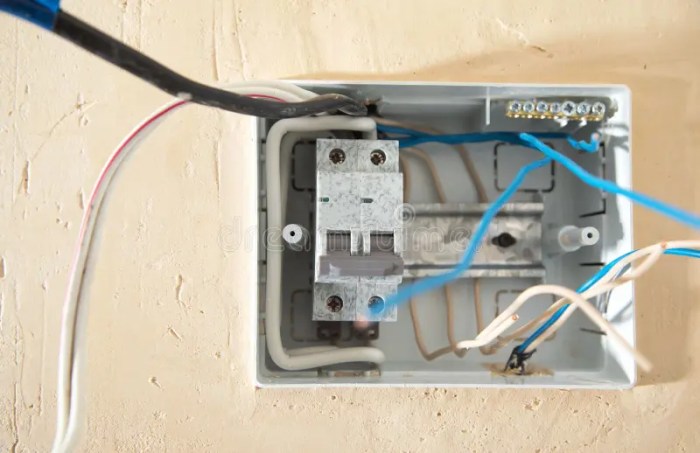






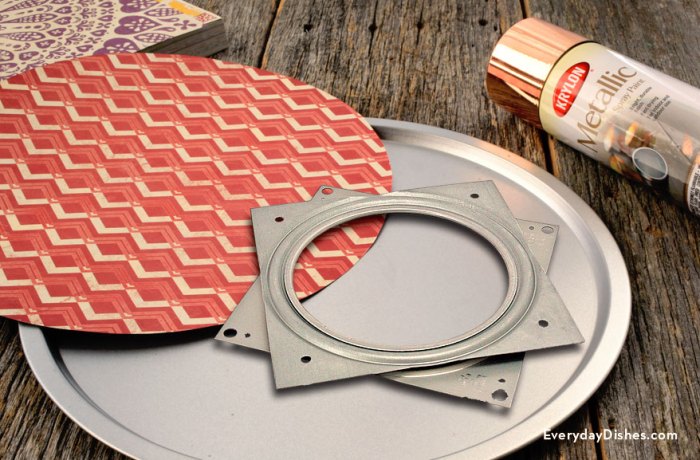
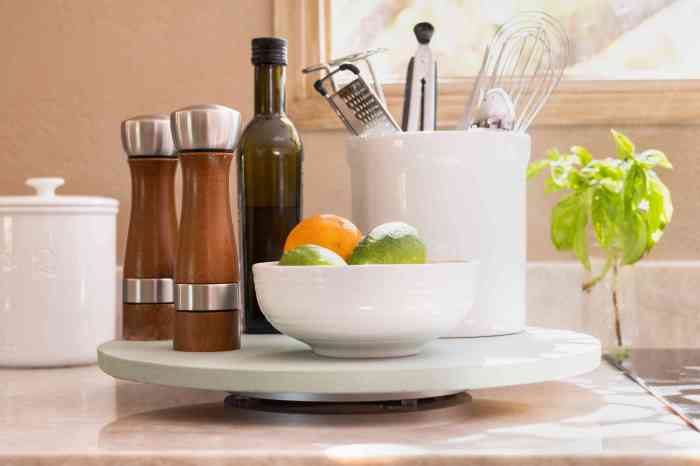
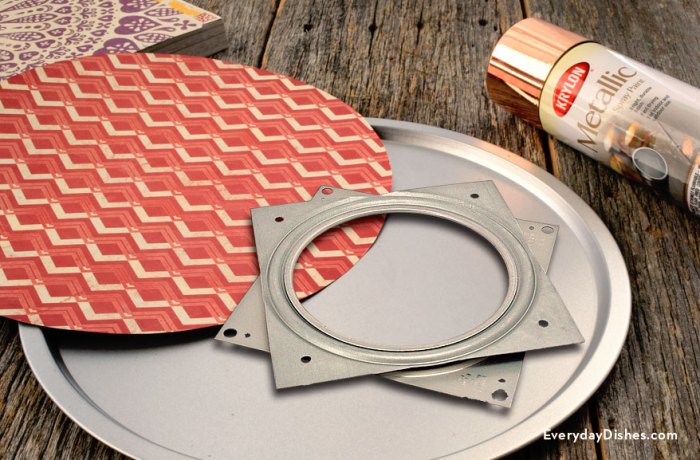

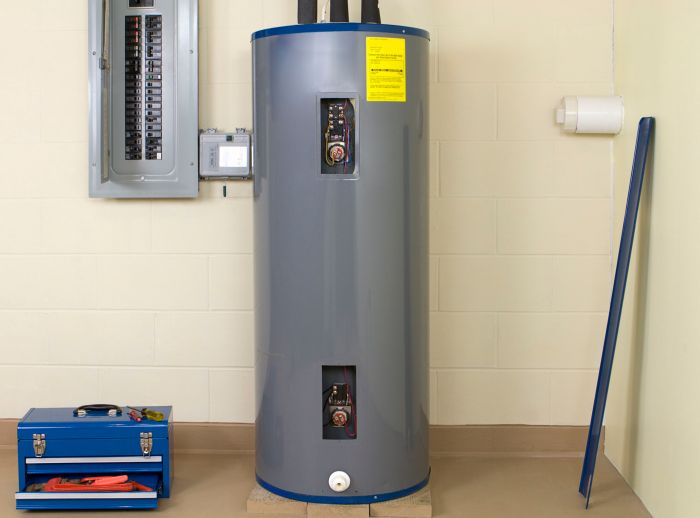
 Sediment Buildup Illustration: This illustration depicts a water heater tank with a substantial layer of sediment at the bottom. The sediment is a yellowish-tan substance.
Sediment Buildup Illustration: This illustration depicts a water heater tank with a substantial layer of sediment at the bottom. The sediment is a yellowish-tan substance. Loose Connections Illustration: This illustration shows a water heater with loose connections at the gas line, electrical wiring, and water supply pipes. The connections are highlighted with arrows and are visibly loose, indicating a potential problem.
Loose Connections Illustration: This illustration shows a water heater with loose connections at the gas line, electrical wiring, and water supply pipes. The connections are highlighted with arrows and are visibly loose, indicating a potential problem. Internal Components Illustration: This diagram provides a detailed view of the internal components of a water heater, including the tank, heating element, pressure relief valve, and thermostat. Each component is labeled, making it easy to identify potential problem areas.
Internal Components Illustration: This diagram provides a detailed view of the internal components of a water heater, including the tank, heating element, pressure relief valve, and thermostat. Each component is labeled, making it easy to identify potential problem areas.
